Corporate Governance Assessment: Arcelor Mittal Merger Analysis
VerifiedAdded on 2023/01/06
|8
|2550
|84
Case Study
AI Summary
This case study delves into the corporate governance of Arcelor Mittal following its merger. It assesses the post-merger board structure, highlighting the pros and cons, particularly the dominance of the Mittal family and the role of non-executive directors. The analysis examines the impact of institutional investors on governance, discussing their potential contributions and limitations within the existing framework. Furthermore, the study compares the effectiveness of the pre-merger Mittal Steel board with the post-merger structure, considering the positive and negative impacts of the merger on governance practices. The case study references the Financial Times article and provides a comprehensive overview of the challenges and opportunities in corporate governance within the context of this significant merger, including discussions of conflicts of interest, transparency, and the influence of key stakeholders.
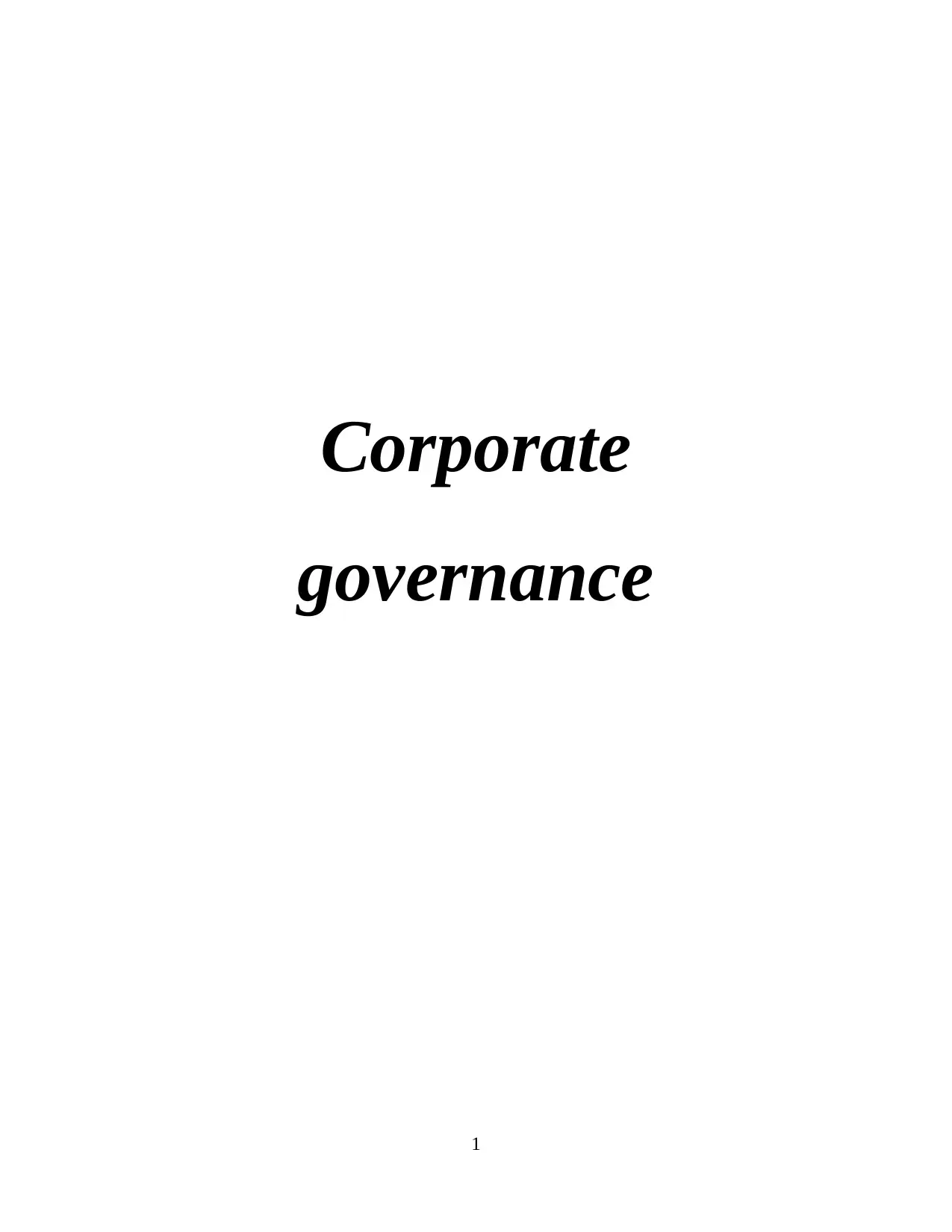
Corporate
governance
1
governance
1
Paraphrase This Document
Need a fresh take? Get an instant paraphrase of this document with our AI Paraphraser
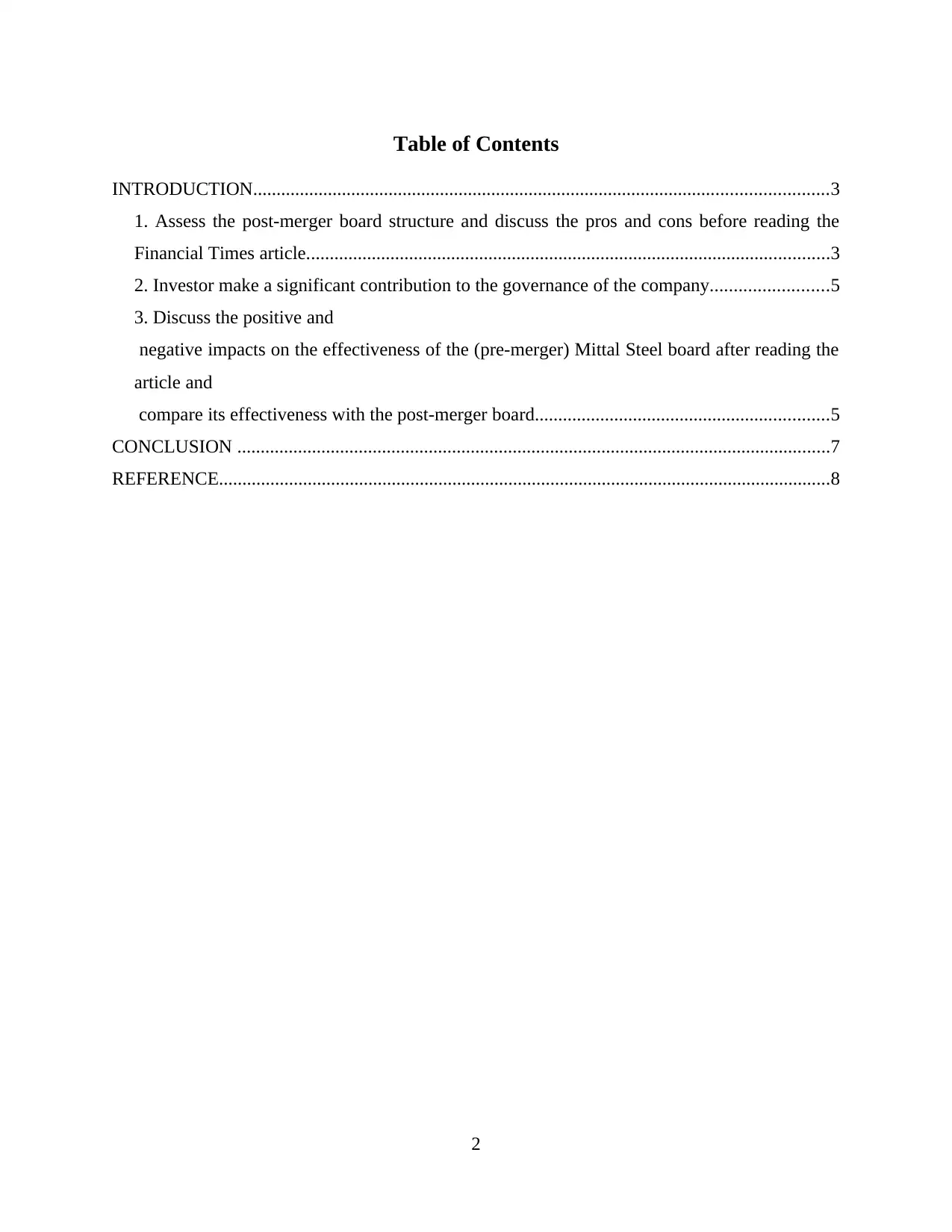
Table of Contents
INTRODUCTION...........................................................................................................................3
1. Assess the post-merger board structure and discuss the pros and cons before reading the
Financial Times article................................................................................................................3
2. Investor make a significant contribution to the governance of the company.........................5
3. Discuss the positive and
negative impacts on the effectiveness of the (pre-merger) Mittal Steel board after reading the
article and
compare its effectiveness with the post-merger board...............................................................5
CONCLUSION ...............................................................................................................................7
REFERENCE...................................................................................................................................8
2
INTRODUCTION...........................................................................................................................3
1. Assess the post-merger board structure and discuss the pros and cons before reading the
Financial Times article................................................................................................................3
2. Investor make a significant contribution to the governance of the company.........................5
3. Discuss the positive and
negative impacts on the effectiveness of the (pre-merger) Mittal Steel board after reading the
article and
compare its effectiveness with the post-merger board...............................................................5
CONCLUSION ...............................................................................................................................7
REFERENCE...................................................................................................................................8
2
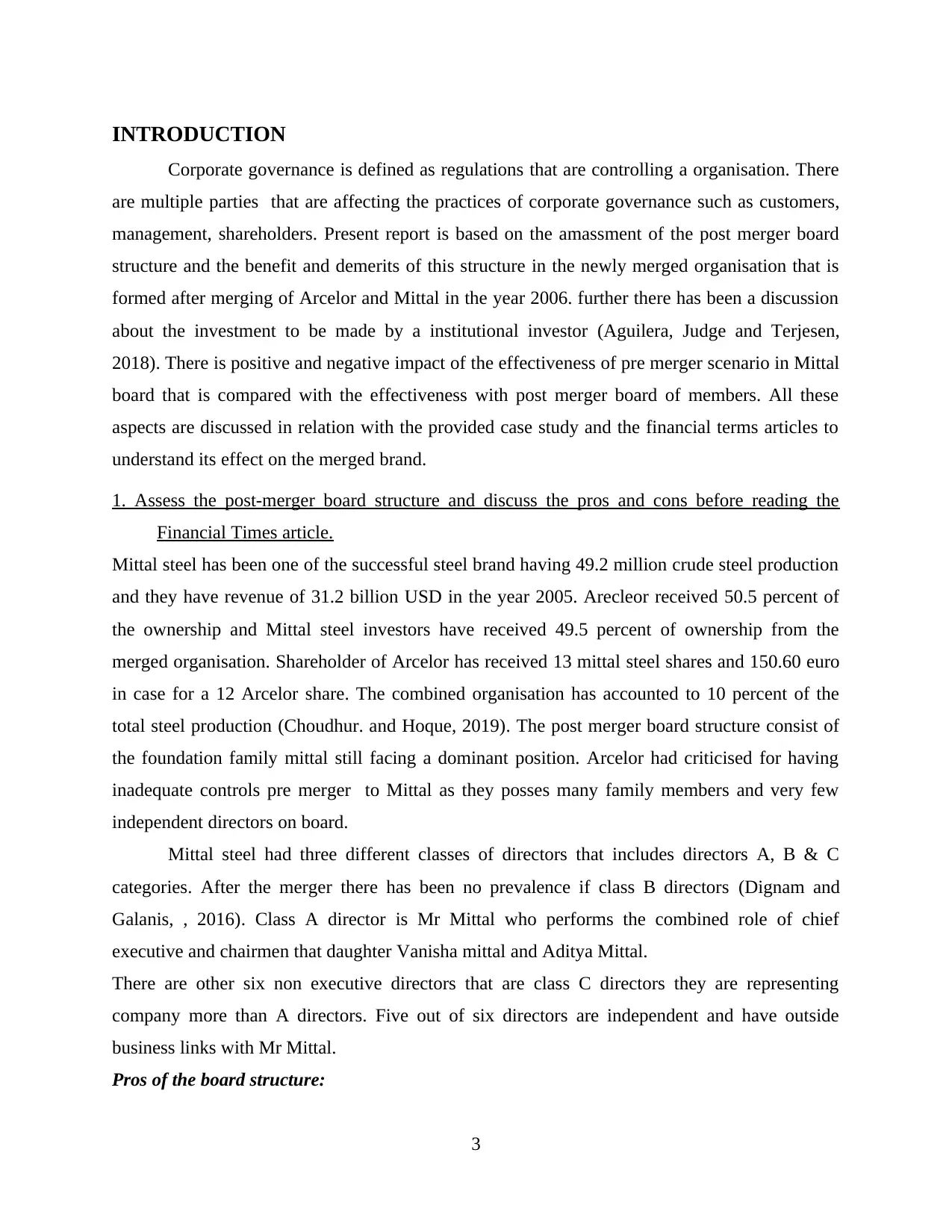
INTRODUCTION
Corporate governance is defined as regulations that are controlling a organisation. There
are multiple parties that are affecting the practices of corporate governance such as customers,
management, shareholders. Present report is based on the amassment of the post merger board
structure and the benefit and demerits of this structure in the newly merged organisation that is
formed after merging of Arcelor and Mittal in the year 2006. further there has been a discussion
about the investment to be made by a institutional investor (Aguilera, Judge and Terjesen,
2018). There is positive and negative impact of the effectiveness of pre merger scenario in Mittal
board that is compared with the effectiveness with post merger board of members. All these
aspects are discussed in relation with the provided case study and the financial terms articles to
understand its effect on the merged brand.
1. Assess the post-merger board structure and discuss the pros and cons before reading the
Financial Times article.
Mittal steel has been one of the successful steel brand having 49.2 million crude steel production
and they have revenue of 31.2 billion USD in the year 2005. Arecleor received 50.5 percent of
the ownership and Mittal steel investors have received 49.5 percent of ownership from the
merged organisation. Shareholder of Arcelor has received 13 mittal steel shares and 150.60 euro
in case for a 12 Arcelor share. The combined organisation has accounted to 10 percent of the
total steel production (Choudhur. and Hoque, 2019). The post merger board structure consist of
the foundation family mittal still facing a dominant position. Arcelor had criticised for having
inadequate controls pre merger to Mittal as they posses many family members and very few
independent directors on board.
Mittal steel had three different classes of directors that includes directors A, B & C
categories. After the merger there has been no prevalence if class B directors (Dignam and
Galanis, , 2016). Class A director is Mr Mittal who performs the combined role of chief
executive and chairmen that daughter Vanisha mittal and Aditya Mittal.
There are other six non executive directors that are class C directors they are representing
company more than A directors. Five out of six directors are independent and have outside
business links with Mr Mittal.
Pros of the board structure:
3
Corporate governance is defined as regulations that are controlling a organisation. There
are multiple parties that are affecting the practices of corporate governance such as customers,
management, shareholders. Present report is based on the amassment of the post merger board
structure and the benefit and demerits of this structure in the newly merged organisation that is
formed after merging of Arcelor and Mittal in the year 2006. further there has been a discussion
about the investment to be made by a institutional investor (Aguilera, Judge and Terjesen,
2018). There is positive and negative impact of the effectiveness of pre merger scenario in Mittal
board that is compared with the effectiveness with post merger board of members. All these
aspects are discussed in relation with the provided case study and the financial terms articles to
understand its effect on the merged brand.
1. Assess the post-merger board structure and discuss the pros and cons before reading the
Financial Times article.
Mittal steel has been one of the successful steel brand having 49.2 million crude steel production
and they have revenue of 31.2 billion USD in the year 2005. Arecleor received 50.5 percent of
the ownership and Mittal steel investors have received 49.5 percent of ownership from the
merged organisation. Shareholder of Arcelor has received 13 mittal steel shares and 150.60 euro
in case for a 12 Arcelor share. The combined organisation has accounted to 10 percent of the
total steel production (Choudhur. and Hoque, 2019). The post merger board structure consist of
the foundation family mittal still facing a dominant position. Arcelor had criticised for having
inadequate controls pre merger to Mittal as they posses many family members and very few
independent directors on board.
Mittal steel had three different classes of directors that includes directors A, B & C
categories. After the merger there has been no prevalence if class B directors (Dignam and
Galanis, , 2016). Class A director is Mr Mittal who performs the combined role of chief
executive and chairmen that daughter Vanisha mittal and Aditya Mittal.
There are other six non executive directors that are class C directors they are representing
company more than A directors. Five out of six directors are independent and have outside
business links with Mr Mittal.
Pros of the board structure:
3
⊘ This is a preview!⊘
Do you want full access?
Subscribe today to unlock all pages.

Trusted by 1+ million students worldwide
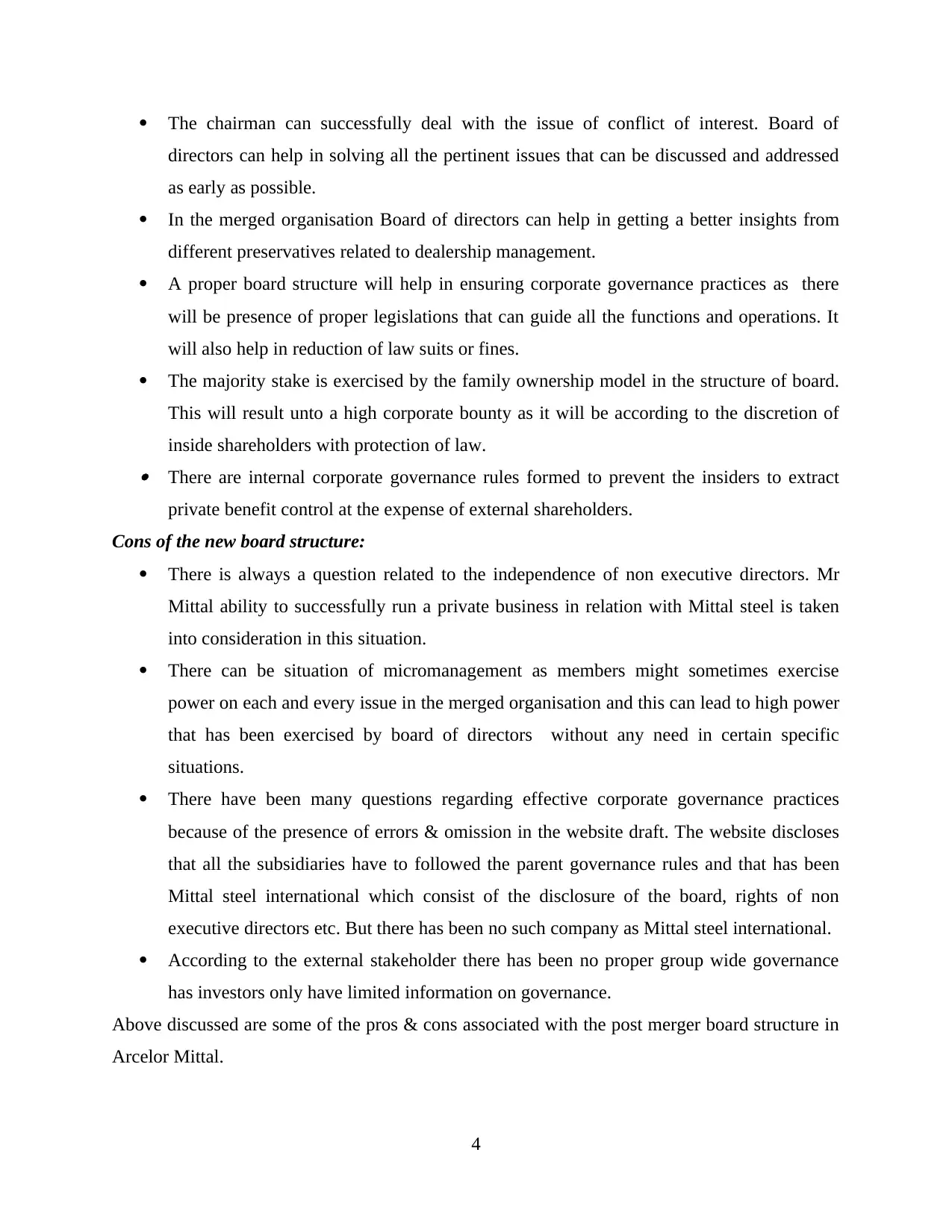
The chairman can successfully deal with the issue of conflict of interest. Board of
directors can help in solving all the pertinent issues that can be discussed and addressed
as early as possible.
In the merged organisation Board of directors can help in getting a better insights from
different preservatives related to dealership management.
A proper board structure will help in ensuring corporate governance practices as there
will be presence of proper legislations that can guide all the functions and operations. It
will also help in reduction of law suits or fines.
The majority stake is exercised by the family ownership model in the structure of board.
This will result unto a high corporate bounty as it will be according to the discretion of
inside shareholders with protection of law. There are internal corporate governance rules formed to prevent the insiders to extract
private benefit control at the expense of external shareholders.
Cons of the new board structure:
There is always a question related to the independence of non executive directors. Mr
Mittal ability to successfully run a private business in relation with Mittal steel is taken
into consideration in this situation.
There can be situation of micromanagement as members might sometimes exercise
power on each and every issue in the merged organisation and this can lead to high power
that has been exercised by board of directors without any need in certain specific
situations.
There have been many questions regarding effective corporate governance practices
because of the presence of errors & omission in the website draft. The website discloses
that all the subsidiaries have to followed the parent governance rules and that has been
Mittal steel international which consist of the disclosure of the board, rights of non
executive directors etc. But there has been no such company as Mittal steel international.
According to the external stakeholder there has been no proper group wide governance
has investors only have limited information on governance.
Above discussed are some of the pros & cons associated with the post merger board structure in
Arcelor Mittal.
4
directors can help in solving all the pertinent issues that can be discussed and addressed
as early as possible.
In the merged organisation Board of directors can help in getting a better insights from
different preservatives related to dealership management.
A proper board structure will help in ensuring corporate governance practices as there
will be presence of proper legislations that can guide all the functions and operations. It
will also help in reduction of law suits or fines.
The majority stake is exercised by the family ownership model in the structure of board.
This will result unto a high corporate bounty as it will be according to the discretion of
inside shareholders with protection of law. There are internal corporate governance rules formed to prevent the insiders to extract
private benefit control at the expense of external shareholders.
Cons of the new board structure:
There is always a question related to the independence of non executive directors. Mr
Mittal ability to successfully run a private business in relation with Mittal steel is taken
into consideration in this situation.
There can be situation of micromanagement as members might sometimes exercise
power on each and every issue in the merged organisation and this can lead to high power
that has been exercised by board of directors without any need in certain specific
situations.
There have been many questions regarding effective corporate governance practices
because of the presence of errors & omission in the website draft. The website discloses
that all the subsidiaries have to followed the parent governance rules and that has been
Mittal steel international which consist of the disclosure of the board, rights of non
executive directors etc. But there has been no such company as Mittal steel international.
According to the external stakeholder there has been no proper group wide governance
has investors only have limited information on governance.
Above discussed are some of the pros & cons associated with the post merger board structure in
Arcelor Mittal.
4
Paraphrase This Document
Need a fresh take? Get an instant paraphrase of this document with our AI Paraphraser
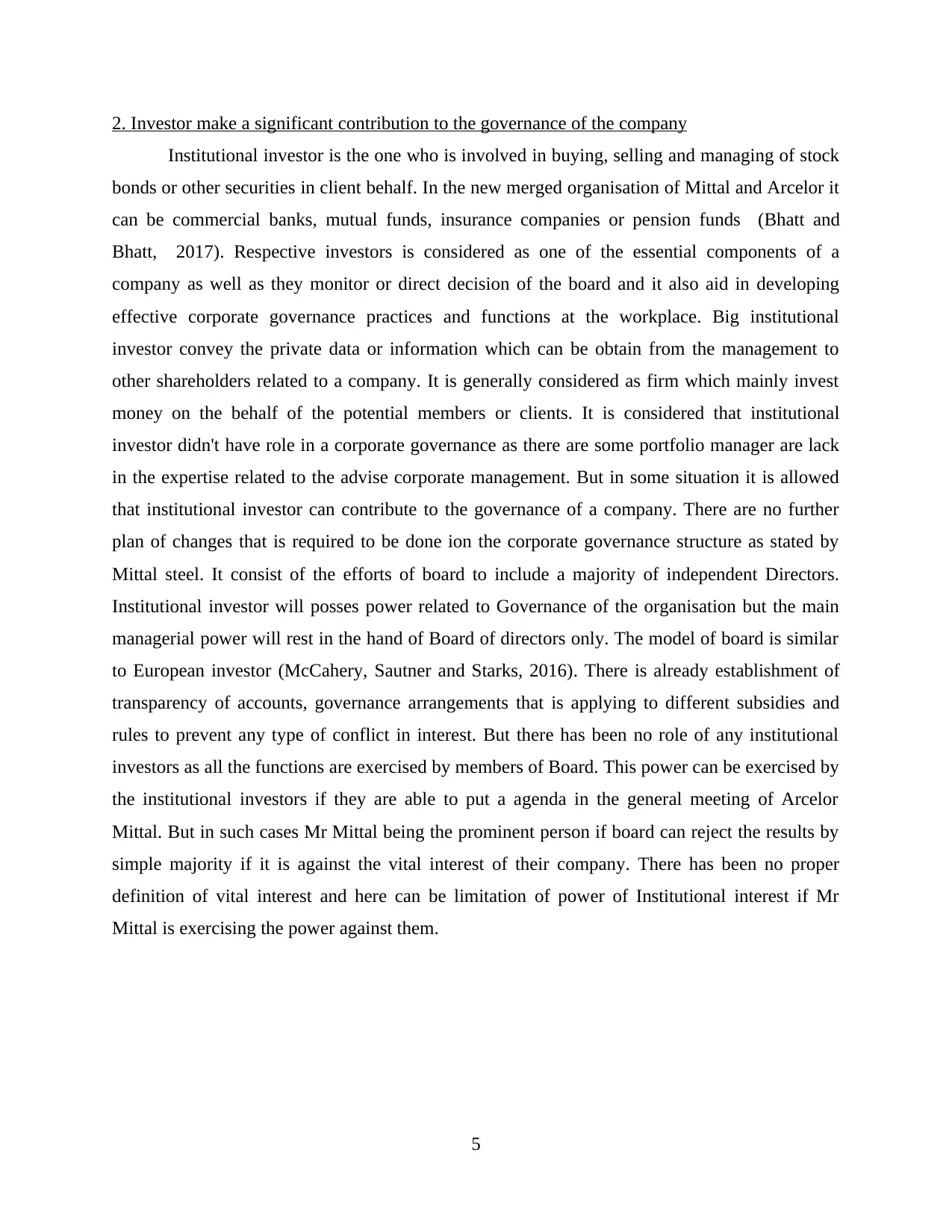
2. Investor make a significant contribution to the governance of the company
Institutional investor is the one who is involved in buying, selling and managing of stock
bonds or other securities in client behalf. In the new merged organisation of Mittal and Arcelor it
can be commercial banks, mutual funds, insurance companies or pension funds (Bhatt and
Bhatt, 2017). Respective investors is considered as one of the essential components of a
company as well as they monitor or direct decision of the board and it also aid in developing
effective corporate governance practices and functions at the workplace. Big institutional
investor convey the private data or information which can be obtain from the management to
other shareholders related to a company. It is generally considered as firm which mainly invest
money on the behalf of the potential members or clients. It is considered that institutional
investor didn't have role in a corporate governance as there are some portfolio manager are lack
in the expertise related to the advise corporate management. But in some situation it is allowed
that institutional investor can contribute to the governance of a company. There are no further
plan of changes that is required to be done ion the corporate governance structure as stated by
Mittal steel. It consist of the efforts of board to include a majority of independent Directors.
Institutional investor will posses power related to Governance of the organisation but the main
managerial power will rest in the hand of Board of directors only. The model of board is similar
to European investor (McCahery, Sautner and Starks, 2016). There is already establishment of
transparency of accounts, governance arrangements that is applying to different subsidies and
rules to prevent any type of conflict in interest. But there has been no role of any institutional
investors as all the functions are exercised by members of Board. This power can be exercised by
the institutional investors if they are able to put a agenda in the general meeting of Arcelor
Mittal. But in such cases Mr Mittal being the prominent person if board can reject the results by
simple majority if it is against the vital interest of their company. There has been no proper
definition of vital interest and here can be limitation of power of Institutional interest if Mr
Mittal is exercising the power against them.
5
Institutional investor is the one who is involved in buying, selling and managing of stock
bonds or other securities in client behalf. In the new merged organisation of Mittal and Arcelor it
can be commercial banks, mutual funds, insurance companies or pension funds (Bhatt and
Bhatt, 2017). Respective investors is considered as one of the essential components of a
company as well as they monitor or direct decision of the board and it also aid in developing
effective corporate governance practices and functions at the workplace. Big institutional
investor convey the private data or information which can be obtain from the management to
other shareholders related to a company. It is generally considered as firm which mainly invest
money on the behalf of the potential members or clients. It is considered that institutional
investor didn't have role in a corporate governance as there are some portfolio manager are lack
in the expertise related to the advise corporate management. But in some situation it is allowed
that institutional investor can contribute to the governance of a company. There are no further
plan of changes that is required to be done ion the corporate governance structure as stated by
Mittal steel. It consist of the efforts of board to include a majority of independent Directors.
Institutional investor will posses power related to Governance of the organisation but the main
managerial power will rest in the hand of Board of directors only. The model of board is similar
to European investor (McCahery, Sautner and Starks, 2016). There is already establishment of
transparency of accounts, governance arrangements that is applying to different subsidies and
rules to prevent any type of conflict in interest. But there has been no role of any institutional
investors as all the functions are exercised by members of Board. This power can be exercised by
the institutional investors if they are able to put a agenda in the general meeting of Arcelor
Mittal. But in such cases Mr Mittal being the prominent person if board can reject the results by
simple majority if it is against the vital interest of their company. There has been no proper
definition of vital interest and here can be limitation of power of Institutional interest if Mr
Mittal is exercising the power against them.
5
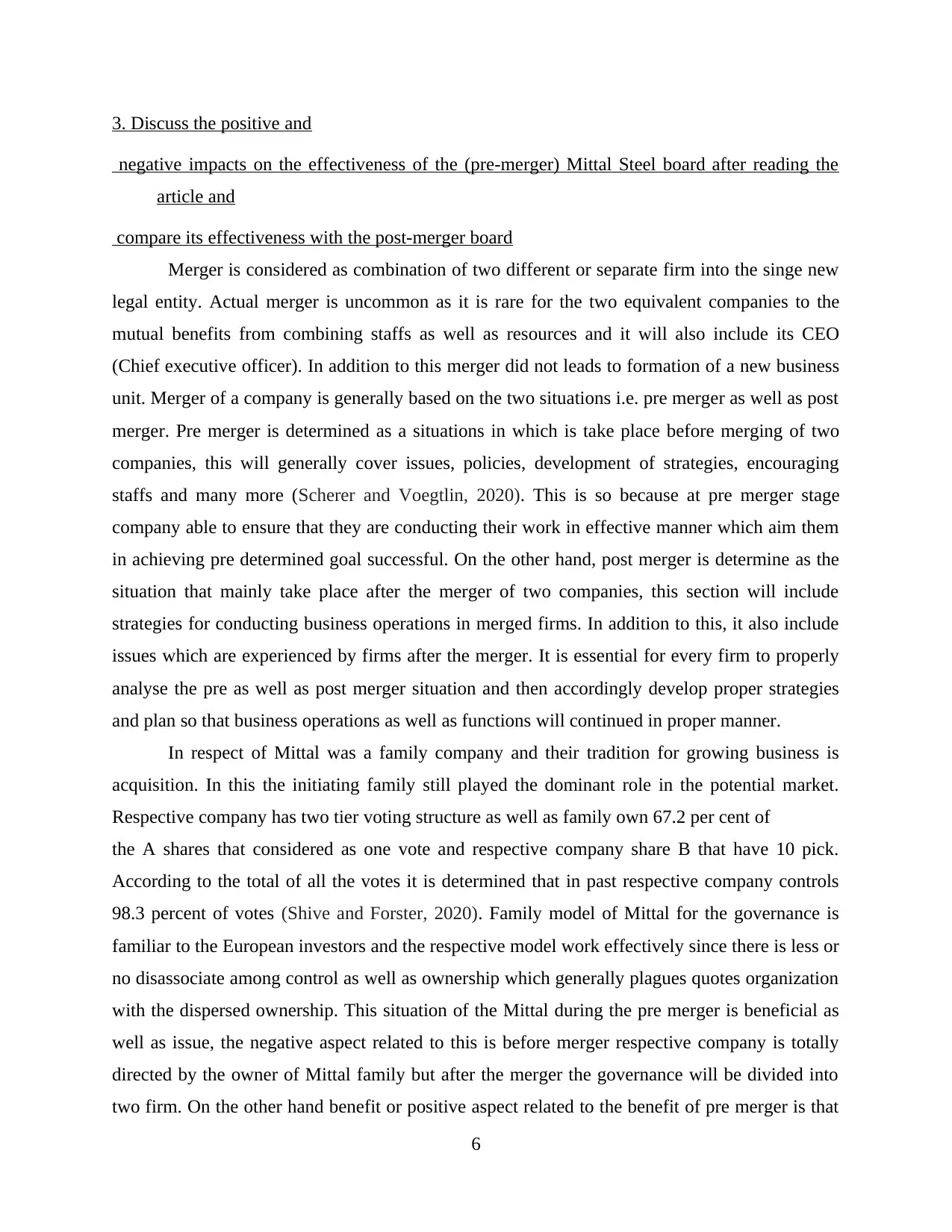
3. Discuss the positive and
negative impacts on the effectiveness of the (pre-merger) Mittal Steel board after reading the
article and
compare its effectiveness with the post-merger board
Merger is considered as combination of two different or separate firm into the singe new
legal entity. Actual merger is uncommon as it is rare for the two equivalent companies to the
mutual benefits from combining staffs as well as resources and it will also include its CEO
(Chief executive officer). In addition to this merger did not leads to formation of a new business
unit. Merger of a company is generally based on the two situations i.e. pre merger as well as post
merger. Pre merger is determined as a situations in which is take place before merging of two
companies, this will generally cover issues, policies, development of strategies, encouraging
staffs and many more (Scherer and Voegtlin, 2020). This is so because at pre merger stage
company able to ensure that they are conducting their work in effective manner which aim them
in achieving pre determined goal successful. On the other hand, post merger is determine as the
situation that mainly take place after the merger of two companies, this section will include
strategies for conducting business operations in merged firms. In addition to this, it also include
issues which are experienced by firms after the merger. It is essential for every firm to properly
analyse the pre as well as post merger situation and then accordingly develop proper strategies
and plan so that business operations as well as functions will continued in proper manner.
In respect of Mittal was a family company and their tradition for growing business is
acquisition. In this the initiating family still played the dominant role in the potential market.
Respective company has two tier voting structure as well as family own 67.2 per cent of
the A shares that considered as one vote and respective company share B that have 10 pick.
According to the total of all the votes it is determined that in past respective company controls
98.3 percent of votes (Shive and Forster, 2020). Family model of Mittal for the governance is
familiar to the European investors and the respective model work effectively since there is less or
no disassociate among control as well as ownership which generally plagues quotes organization
with the dispersed ownership. This situation of the Mittal during the pre merger is beneficial as
well as issue, the negative aspect related to this is before merger respective company is totally
directed by the owner of Mittal family but after the merger the governance will be divided into
two firm. On the other hand benefit or positive aspect related to the benefit of pre merger is that
6
negative impacts on the effectiveness of the (pre-merger) Mittal Steel board after reading the
article and
compare its effectiveness with the post-merger board
Merger is considered as combination of two different or separate firm into the singe new
legal entity. Actual merger is uncommon as it is rare for the two equivalent companies to the
mutual benefits from combining staffs as well as resources and it will also include its CEO
(Chief executive officer). In addition to this merger did not leads to formation of a new business
unit. Merger of a company is generally based on the two situations i.e. pre merger as well as post
merger. Pre merger is determined as a situations in which is take place before merging of two
companies, this will generally cover issues, policies, development of strategies, encouraging
staffs and many more (Scherer and Voegtlin, 2020). This is so because at pre merger stage
company able to ensure that they are conducting their work in effective manner which aim them
in achieving pre determined goal successful. On the other hand, post merger is determine as the
situation that mainly take place after the merger of two companies, this section will include
strategies for conducting business operations in merged firms. In addition to this, it also include
issues which are experienced by firms after the merger. It is essential for every firm to properly
analyse the pre as well as post merger situation and then accordingly develop proper strategies
and plan so that business operations as well as functions will continued in proper manner.
In respect of Mittal was a family company and their tradition for growing business is
acquisition. In this the initiating family still played the dominant role in the potential market.
Respective company has two tier voting structure as well as family own 67.2 per cent of
the A shares that considered as one vote and respective company share B that have 10 pick.
According to the total of all the votes it is determined that in past respective company controls
98.3 percent of votes (Shive and Forster, 2020). Family model of Mittal for the governance is
familiar to the European investors and the respective model work effectively since there is less or
no disassociate among control as well as ownership which generally plagues quotes organization
with the dispersed ownership. This situation of the Mittal during the pre merger is beneficial as
well as issue, the negative aspect related to this is before merger respective company is totally
directed by the owner of Mittal family but after the merger the governance will be divided into
two firm. On the other hand benefit or positive aspect related to the benefit of pre merger is that
6
⊘ This is a preview!⊘
Do you want full access?
Subscribe today to unlock all pages.

Trusted by 1+ million students worldwide
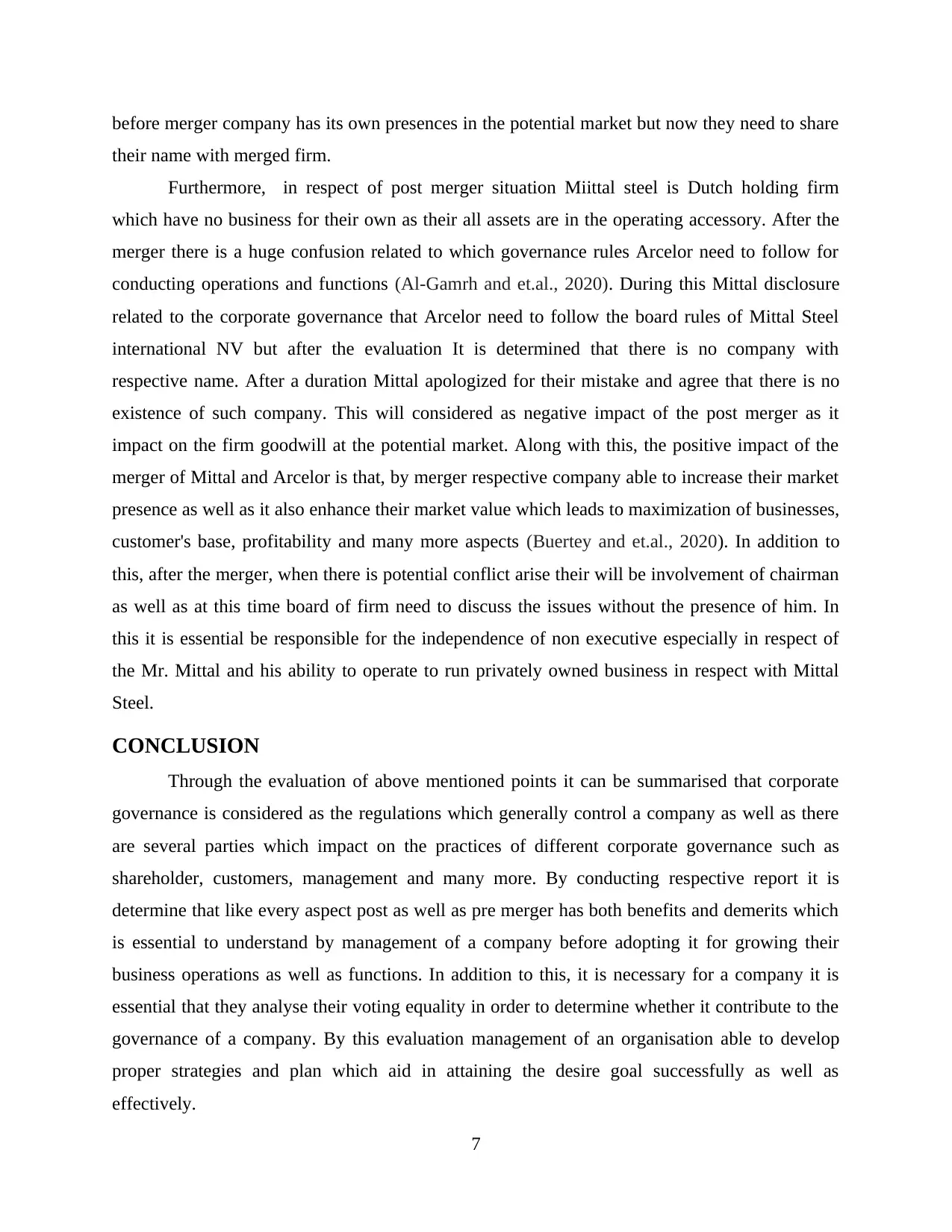
before merger company has its own presences in the potential market but now they need to share
their name with merged firm.
Furthermore, in respect of post merger situation Miittal steel is Dutch holding firm
which have no business for their own as their all assets are in the operating accessory. After the
merger there is a huge confusion related to which governance rules Arcelor need to follow for
conducting operations and functions (Al-Gamrh and et.al., 2020). During this Mittal disclosure
related to the corporate governance that Arcelor need to follow the board rules of Mittal Steel
international NV but after the evaluation It is determined that there is no company with
respective name. After a duration Mittal apologized for their mistake and agree that there is no
existence of such company. This will considered as negative impact of the post merger as it
impact on the firm goodwill at the potential market. Along with this, the positive impact of the
merger of Mittal and Arcelor is that, by merger respective company able to increase their market
presence as well as it also enhance their market value which leads to maximization of businesses,
customer's base, profitability and many more aspects (Buertey and et.al., 2020). In addition to
this, after the merger, when there is potential conflict arise their will be involvement of chairman
as well as at this time board of firm need to discuss the issues without the presence of him. In
this it is essential be responsible for the independence of non executive especially in respect of
the Mr. Mittal and his ability to operate to run privately owned business in respect with Mittal
Steel.
CONCLUSION
Through the evaluation of above mentioned points it can be summarised that corporate
governance is considered as the regulations which generally control a company as well as there
are several parties which impact on the practices of different corporate governance such as
shareholder, customers, management and many more. By conducting respective report it is
determine that like every aspect post as well as pre merger has both benefits and demerits which
is essential to understand by management of a company before adopting it for growing their
business operations as well as functions. In addition to this, it is necessary for a company it is
essential that they analyse their voting equality in order to determine whether it contribute to the
governance of a company. By this evaluation management of an organisation able to develop
proper strategies and plan which aid in attaining the desire goal successfully as well as
effectively.
7
their name with merged firm.
Furthermore, in respect of post merger situation Miittal steel is Dutch holding firm
which have no business for their own as their all assets are in the operating accessory. After the
merger there is a huge confusion related to which governance rules Arcelor need to follow for
conducting operations and functions (Al-Gamrh and et.al., 2020). During this Mittal disclosure
related to the corporate governance that Arcelor need to follow the board rules of Mittal Steel
international NV but after the evaluation It is determined that there is no company with
respective name. After a duration Mittal apologized for their mistake and agree that there is no
existence of such company. This will considered as negative impact of the post merger as it
impact on the firm goodwill at the potential market. Along with this, the positive impact of the
merger of Mittal and Arcelor is that, by merger respective company able to increase their market
presence as well as it also enhance their market value which leads to maximization of businesses,
customer's base, profitability and many more aspects (Buertey and et.al., 2020). In addition to
this, after the merger, when there is potential conflict arise their will be involvement of chairman
as well as at this time board of firm need to discuss the issues without the presence of him. In
this it is essential be responsible for the independence of non executive especially in respect of
the Mr. Mittal and his ability to operate to run privately owned business in respect with Mittal
Steel.
CONCLUSION
Through the evaluation of above mentioned points it can be summarised that corporate
governance is considered as the regulations which generally control a company as well as there
are several parties which impact on the practices of different corporate governance such as
shareholder, customers, management and many more. By conducting respective report it is
determine that like every aspect post as well as pre merger has both benefits and demerits which
is essential to understand by management of a company before adopting it for growing their
business operations as well as functions. In addition to this, it is necessary for a company it is
essential that they analyse their voting equality in order to determine whether it contribute to the
governance of a company. By this evaluation management of an organisation able to develop
proper strategies and plan which aid in attaining the desire goal successfully as well as
effectively.
7
Paraphrase This Document
Need a fresh take? Get an instant paraphrase of this document with our AI Paraphraser
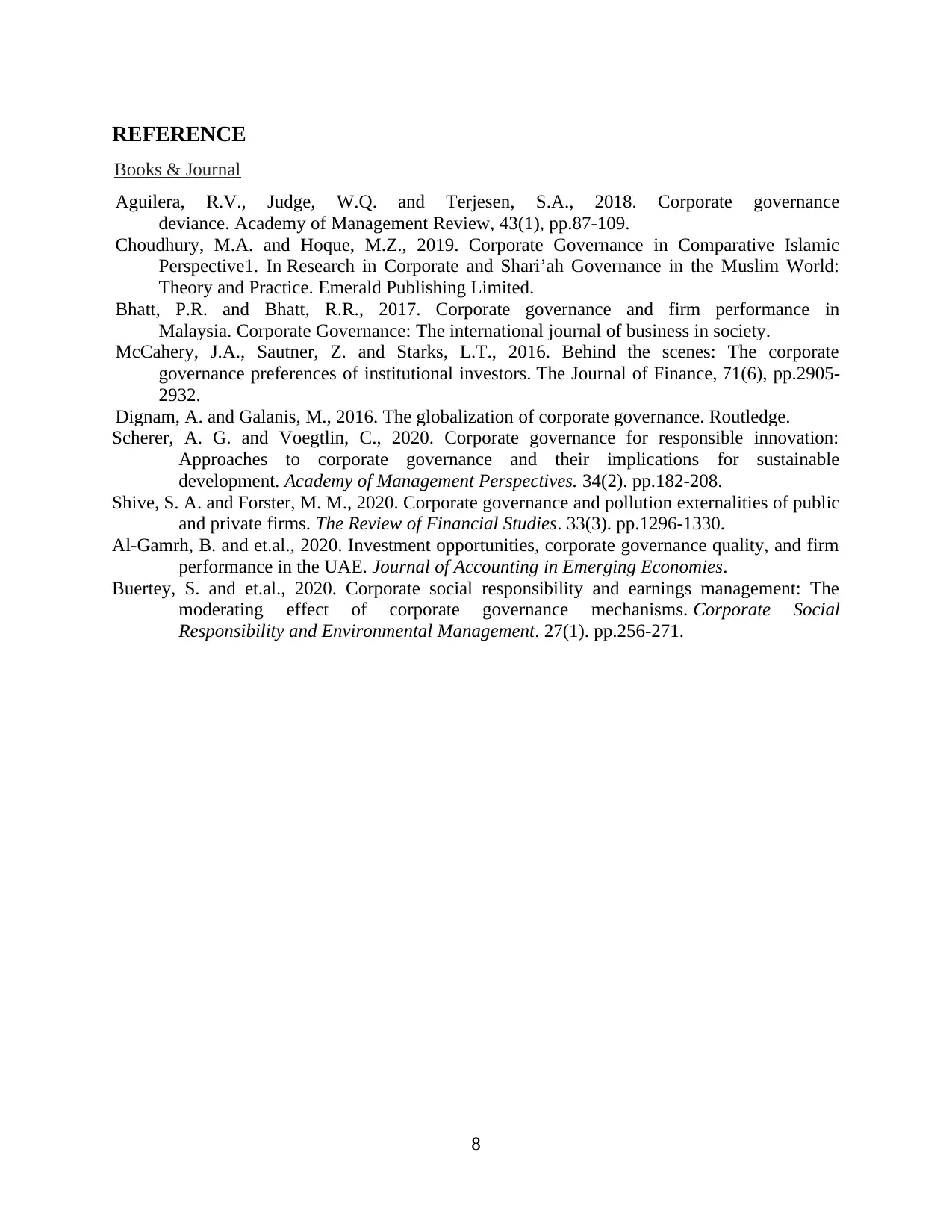
REFERENCE
Books & Journal
Aguilera, R.V., Judge, W.Q. and Terjesen, S.A., 2018. Corporate governance
deviance. Academy of Management Review, 43(1), pp.87-109.
Choudhury, M.A. and Hoque, M.Z., 2019. Corporate Governance in Comparative Islamic
Perspective1. In Research in Corporate and Shari’ah Governance in the Muslim World:
Theory and Practice. Emerald Publishing Limited.
Bhatt, P.R. and Bhatt, R.R., 2017. Corporate governance and firm performance in
Malaysia. Corporate Governance: The international journal of business in society.
McCahery, J.A., Sautner, Z. and Starks, L.T., 2016. Behind the scenes: The corporate
governance preferences of institutional investors. The Journal of Finance, 71(6), pp.2905-
2932.
Dignam, A. and Galanis, M., 2016. The globalization of corporate governance. Routledge.
Scherer, A. G. and Voegtlin, C., 2020. Corporate governance for responsible innovation:
Approaches to corporate governance and their implications for sustainable
development. Academy of Management Perspectives. 34(2). pp.182-208.
Shive, S. A. and Forster, M. M., 2020. Corporate governance and pollution externalities of public
and private firms. The Review of Financial Studies. 33(3). pp.1296-1330.
Al-Gamrh, B. and et.al., 2020. Investment opportunities, corporate governance quality, and firm
performance in the UAE. Journal of Accounting in Emerging Economies.
Buertey, S. and et.al., 2020. Corporate social responsibility and earnings management: The
moderating effect of corporate governance mechanisms. Corporate Social
Responsibility and Environmental Management. 27(1). pp.256-271.
8
Books & Journal
Aguilera, R.V., Judge, W.Q. and Terjesen, S.A., 2018. Corporate governance
deviance. Academy of Management Review, 43(1), pp.87-109.
Choudhury, M.A. and Hoque, M.Z., 2019. Corporate Governance in Comparative Islamic
Perspective1. In Research in Corporate and Shari’ah Governance in the Muslim World:
Theory and Practice. Emerald Publishing Limited.
Bhatt, P.R. and Bhatt, R.R., 2017. Corporate governance and firm performance in
Malaysia. Corporate Governance: The international journal of business in society.
McCahery, J.A., Sautner, Z. and Starks, L.T., 2016. Behind the scenes: The corporate
governance preferences of institutional investors. The Journal of Finance, 71(6), pp.2905-
2932.
Dignam, A. and Galanis, M., 2016. The globalization of corporate governance. Routledge.
Scherer, A. G. and Voegtlin, C., 2020. Corporate governance for responsible innovation:
Approaches to corporate governance and their implications for sustainable
development. Academy of Management Perspectives. 34(2). pp.182-208.
Shive, S. A. and Forster, M. M., 2020. Corporate governance and pollution externalities of public
and private firms. The Review of Financial Studies. 33(3). pp.1296-1330.
Al-Gamrh, B. and et.al., 2020. Investment opportunities, corporate governance quality, and firm
performance in the UAE. Journal of Accounting in Emerging Economies.
Buertey, S. and et.al., 2020. Corporate social responsibility and earnings management: The
moderating effect of corporate governance mechanisms. Corporate Social
Responsibility and Environmental Management. 27(1). pp.256-271.
8
1 out of 8
Related Documents
Your All-in-One AI-Powered Toolkit for Academic Success.
+13062052269
info@desklib.com
Available 24*7 on WhatsApp / Email
![[object Object]](/_next/static/media/star-bottom.7253800d.svg)
Unlock your academic potential
Copyright © 2020–2025 A2Z Services. All Rights Reserved. Developed and managed by ZUCOL.


